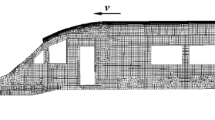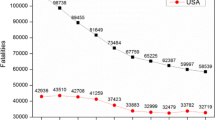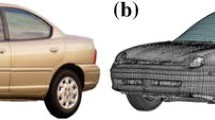Abstract
This paper presents the results of a study on shape optimisation for crashworthiness design of passenger cars based on the software SFE CONCEPT. In contrast to classical morphing approaches, SFE CONCEPT allows for larger geometrical modifications via an implicit parameterisation technique. This is advantageous in particular in the early design phases where different design alternatives are investigated and the optimal and robust geometry needs to be identified. As a first example, the front rail of a standard passenger car is optimised here. This is – as one of the main parts of the body in white – an appropriate example for exploration of optimisation methods. The performance of a classical optimisation approach is analysed and complemented by a robustness analysis where uncertainties in shape parameters are considered.









Similar content being viewed by others
Notes
Simulation ran with finite element code LS-DYNA Livermore Software Technology Company (2009)
Initial speed of the impactor : \(V_{0}=10\;{\rm m.s}^{-1}\)
Mass of the impactor : \(M_{0}= 500\) kg Beam material type : aluminium, modelled with a piecewise linear plasticity law
Simulated impact duration : 20 ms
Computation time : ca. 3 min. on 4 CPUs Intel Xeon E5520
Length of the beam : 400 mm
More details on how the software actually uses the method and which parameters allow to tune the optimisation can be found in the documentation Dynardo (2009)
References
Acar E, Solanki K (2009) System reliability based vehicle design for crashworthiness and effects of various uncertainty reduction measures. Struct Multidiscip Optim 39:311–325
Auweraer HVD, Langenhove TV, Brughmans M, Bosmans I, Masri NE, Donders S (2007) Application of mesh morphing technology in the concept of vehicle development. Int J Veh Des 43:281–305
Baril C, Yacout S, Clement B (2011) Design for six sigma through collaborative multiobjective optimization. Comput Ind Eng 60:43–55
Beyer HG, Sendhoff B (2007) Robust optimization – a comprehensive survey. Comput Methods Appl Mech Eng 196:3190–3218
Delcroix F, Stocki R, Rutjes N, Happee R (2007) Methodologies and algorithms for robust optimization. Tech. Rep. AP-SP72-011-D, APROSYS, Integrated project on advanced protection system, SP7-Virtual Testing
Duddeck F (2007) Survey on robust design and optimisation for crashworthiness. In: EUROMECH colloquium 482: Efficient methods for robust design and optimization. Queen Mary, University of London, London, UK
Duddeck F (2008) Multidisciplinary optimization of car bodies. Struct Multidiscip Optim 35(4):375–389
Duddeck F, Hunkeler S, Zimmer H, Rota L, Zarroug M (2009) Evaluation of shape optimisation strategies for crashworthiness. In: Weimarer optimization and stochastics Days 6. Weimar, Germany
Dynardo GmbH (2009) OptiSLang Ver 3.1.0, Documentation. Weimar, Germany
EN 10131:2006 (2006) Cold rolled uncoated and zinc or zinc-nickel electrolytically coated low carbon and high yield strength steel flat products for cold forming – tolerances on dimensions and shape
Euro NCAP (2009) Frontal impact, testing protocol
Florian A (1992) An efficient sampling scheme: Latin hypercube sampling. Probabilistic Eng Mech 279:123–130
Hou S, Li Q, Long S, Yang X, Li W (2008) Multiobjective optimization of multi-cell sections for the crashworthiness design. Int J Impact Eng 35(11):1355–1367
Jaynes ET (1957) Information theory and statistical mechanics. Phys Rev 106(4):620–630
Koch P, Yang RJ, Gu L (2004) Design for six sigma through robust optimization. Struct Multidiscip Optim 26:235–248
Livermore Software Technology Company (2009) LS-DYNA version 971 release 4, Keyword user’s manual. Livermore, USA
Loenn D, Fyllingen O, Nilsson L (2010) An approach to robust optimization of impact problems using random samples and meta-modelling. Int J Impact Eng 37:723–734
McKay M, Beckman R, Conover W (1979) A comparison of three methods for selecting values of input variables in the analysis of output from a computer code. Technometrics 21(2):239–245
Rais-Rohani M, Solanki K, Acar E, Eamon C (2010) Shape and sizing optimisation of automotive structures with deterministic and probabilistic design constraints. Int J Veh Des 54(4):309–338
Redhe M, Giger M, Nilsson L (2004) An investigation of structural optimization in structural design using a stochastic approach. Struct Multidiscip Optim 127(6):446–459
SFE GmbH (2009) SFE CONCEPT Ver 4.2.2.3, Reference manual. Berlin, Germany
Sharma N, Suthan Collins J, Sharma B (2010) Parameter-based topology optimization for crashworthiness structures. In: 11th LS-DYNA users conference. Dearborn, USA
Sun G, Li G, Gong Z, Cui X, Yang X, Li Q (2009) Multiobjective robust optimization method for drawbead design in sheet metal forming. Mater Des 31(4):1917–1929
Volz K, Frodl B, Dirschmid F, Stryczek R, Zimmer H (2007) Optimizing topology and shape for crashworthiness in vehicle product development. In: International automotive body congress. Berlin, Germany
Will J, Baldauf H, Bucher C (2006) Robustness evaluations in virtual dimensioning of passive passenger safety and crashworthiness. In: Weimarer optimization and stochastics days 3. Weimar, Germany
Zeguer T, Bates S (2007) Signpost the future: Simultaneous robust and design optimization of a knee bolster. In: Altair engineering CAE technology conference. Gaydon, UK
Zimmer H, Prabhuwaingankar M, Duddeck F (2009) Topology- and geometry-based structural optimisation using implicit parametric models and LS-OPT. In: 7th European LS-DYNA conference. Salzburg, Austria
Acknowledgments
The authors would like to thank Johannes Will from Dynardo GmbH who allowed us to use the software optiSLang which was key to the achievement of this work and L. Lacassin from Arcelor-Mittal who provided some advice on how to define the tolerances of metal sheet thicknesses we used to perform our robustness analysis.
Author information
Authors and Affiliations
Corresponding author
Rights and permissions
About this article
Cite this article
Hunkeler, S., Duddeck, F., Rayamajhi, M. et al. Shape optimisation for crashworthiness followed by a robustness analysis with respect to shape variables. Struct Multidisc Optim 48, 367–378 (2013). https://doi.org/10.1007/s00158-013-0903-z
Received:
Revised:
Accepted:
Published:
Issue Date:
DOI: https://doi.org/10.1007/s00158-013-0903-z




